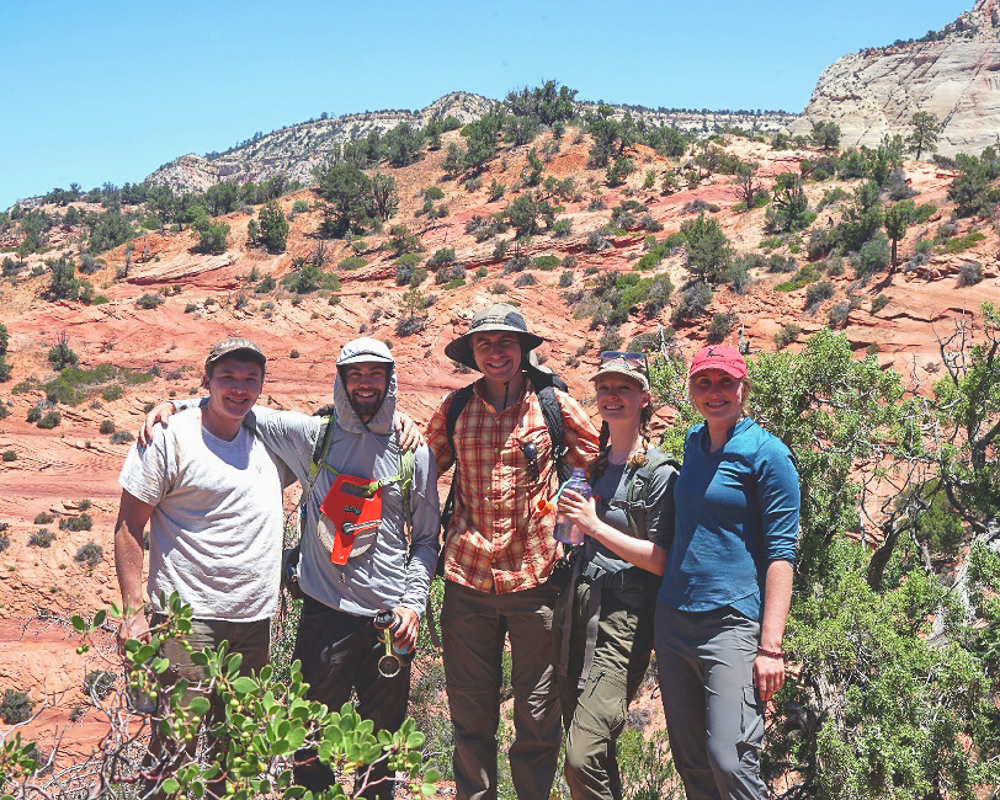Pierce, Morgan, Jack, Audrey, and Demi, posing in front of the spectacularly cross-bedded Jurassic Navajo Sandstone.
Submitted by Ben Surpless (Trinity University)
As the summer research season comes to a close and the new academic year looms, I thought I’d share bits and pieces of our Keck Geology Consortium Advanced Project with family, friends, faculty, and geosociences afficionados. I worked with five students to explore how major fault systems affect the rocks around them. Our research has implications for seismic hazard, groundwater flow, and geothermal energy potential adjacent to similar fault systems worldwide. In the case of the Sevier fault in southern Utah, fault segments have systematically fractured huge rock outcrops of the spectacular, cross-bedded Jurassic Navajo Sandstone, leaving evidence of past earthquakes and tectonic stress fields. Demi Durham (Trinity University), Pierce Hayton (Colorado College), Audrey Jennings (Trinity University), Jack Mrachek (Purdue University), Morgan Sharp (Whitman College) and I worked together in the lab, the field, and on a long road trip to learn more about geology and about each other.
Prepping for the Project
Leading into the start of our in-person project near the end of the spring, students and I used Zoom and frequent emails to communicate about a wide range of topics, including food preferences, camping logistics, computer modeling software, and students’ prior experiences in the geosciences. We discussed what excited them about our research as well as what challenges they anticipated. By the time the in-person project was set to begin, I think all of us were eager to meet face-to-face and jump into our research.
Demi and Audrey arrived on campus in mid-June, and Morgan, Pierce, and Jack arrived soon afterward. The crew moved into Trinity dorms with 200+ other undergraduate summer researchers and got to know the Trinity campus. We worked together for a week, learning about the geology of the Sevier fault zone, the basics of stress fields, strain analysis, and field-based measurements. The students and I also began learning about everyone’s academic journeys, home institutions, and our lives outside of academia. By the time we packed up to hit the road, the students and I were excited to start our research adventure!
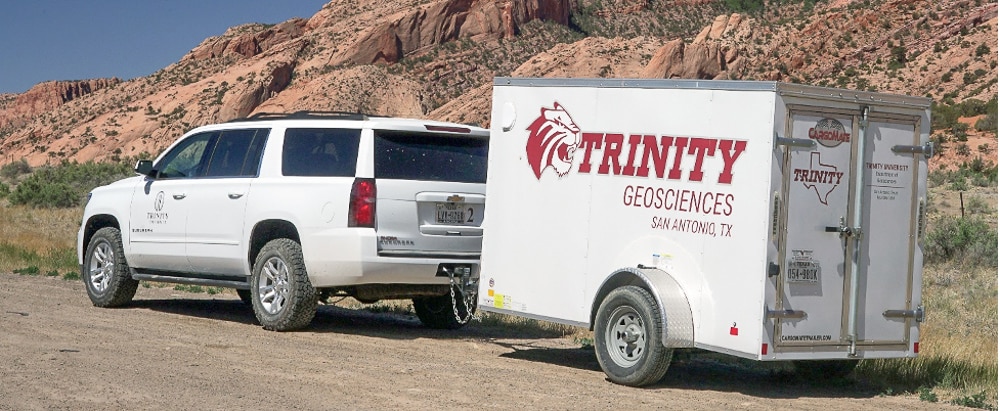
Our field vehicle and gear trailer, somewhere in New Mexico during a pit stop. Throughout our travel to Utah, we rocked out to Taylor Swift, Levels by Avicii (radio edit), and a spectacular range of music, with almost everyone taking a turn as DJ.
Vamanos!
On June 24, we departed Trinity and drove the Trinity Geosciences mobile field lab 1,206 miles to Bauer’s Canyon Ranch and RV Park in Glendale, Utah, which was our base throughout our time in the field. Our travel to Utah was smooth, with no issues en route. By the time we arrived, after 20 hours of talking, sleeping, and serenely taking in the geology of Texas, New Mexico, and Utah, we had learned more about everyone’s journeys to this project.
Upon arrival on June 25, we set up our tents, our field equipment, and our camp kitchen, mentally preparing for the daunting challenges of camping in a remote setting. Not really. We stayed at a campground with showers, laundry, Wi-Fi, and power outlets, so we were, in essence, geo-glamping.
Science on the outcrop and conversations in the camp
During our time in the field, students and I documented rock deformation using sketches, photos, notes, and structural measurements, flew drone missions to gather data from inaccessible outcrops, and spent a lot (lot) of time on the outcrop discussing hypotheses to explain what we saw. Our data revealed variations in fracture intensity and orientation that we could relate to our position relative to the faults that cut through the study area. Some field days were tough, both mentally and physically, but we tried to get into the field as the sun was rising so that we were finishing up before the hottest part of the day was upon us. However, when we did get tired, we could always take a quick nap on the (cross)beds. Early in our time in the field, we came up with a covert operation name that made sense; operation Vulcan’s Hammer achieved every tactical and strategic objective possible – a resounding operational success. No rattlesnake, black widow, or cactus could keep us from our goals! We were invincible!
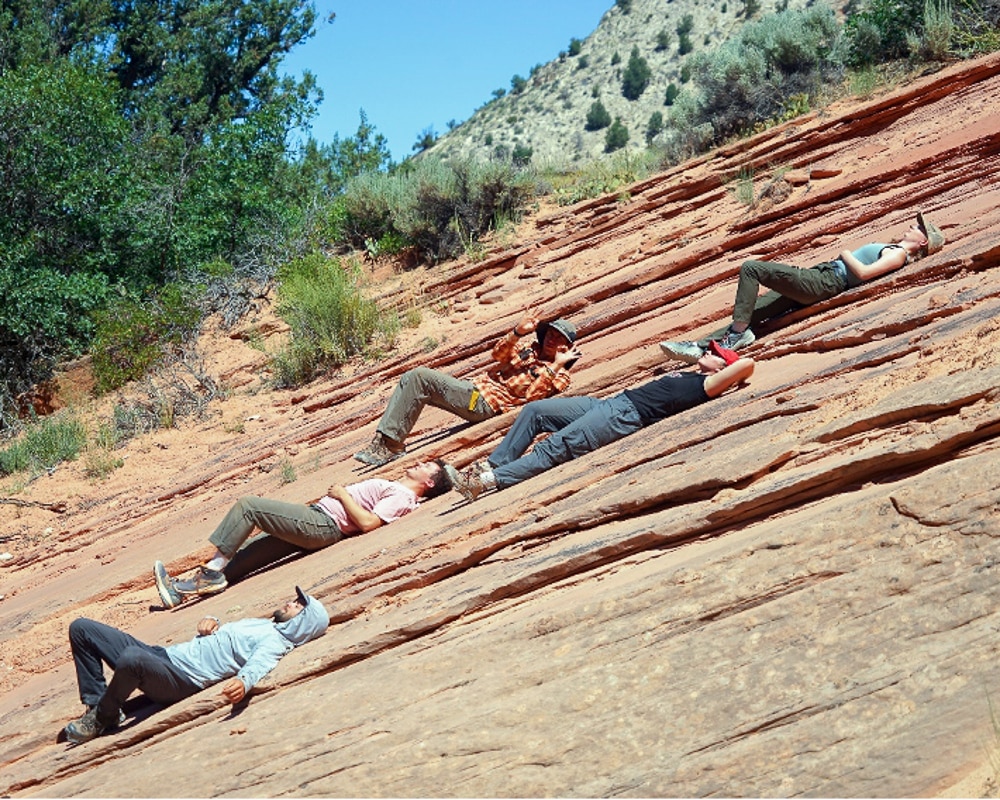
From left to right, Morgan, Pierce, Jack, Demi, and Audrey reclining on the (cross)beds of the Jurassic Navajo Sandstone.
Every night, everyone chipped in to help cook and clean up, and our dinner conversations ranged widely across a sometimes-bizarre spectrum of topics. Jack espoused the amazingness that is Taylor Swift and her discography, Audrey let us know how detestable a handball in the box was in soccer, and we learned about a range of other tangential topics that expanded each of our knowledge horizons. We also made sure to consume our daily allowance of vitamin O (one row of Oreos cookies per person per night) to make sure we had energy for the next day.
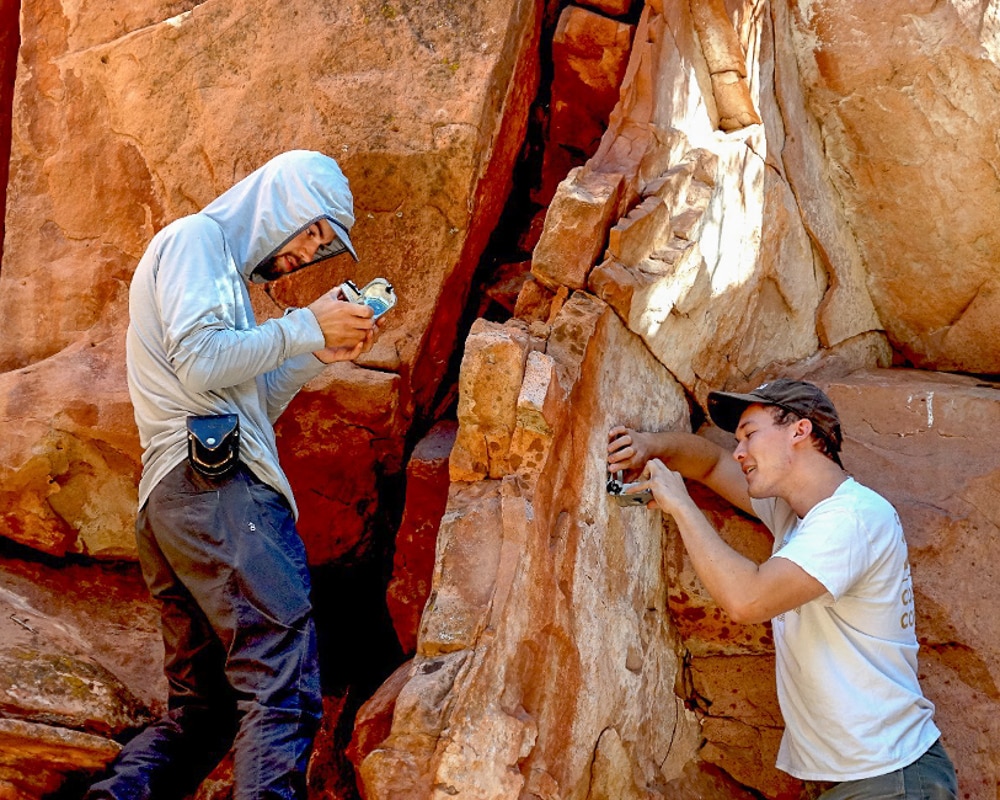
Morgan and Pierce documenting a well-exposed fracture network in the Jurassic Navajo sandstone.
Demi, sketching the outcrop after recording GPS data.
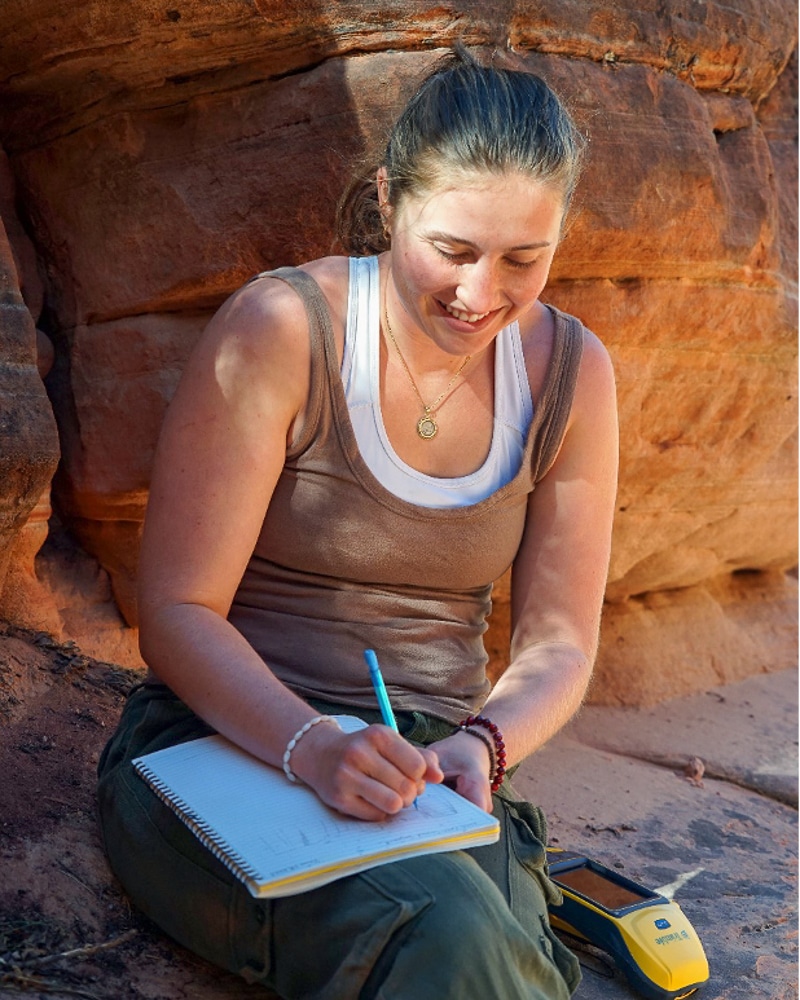
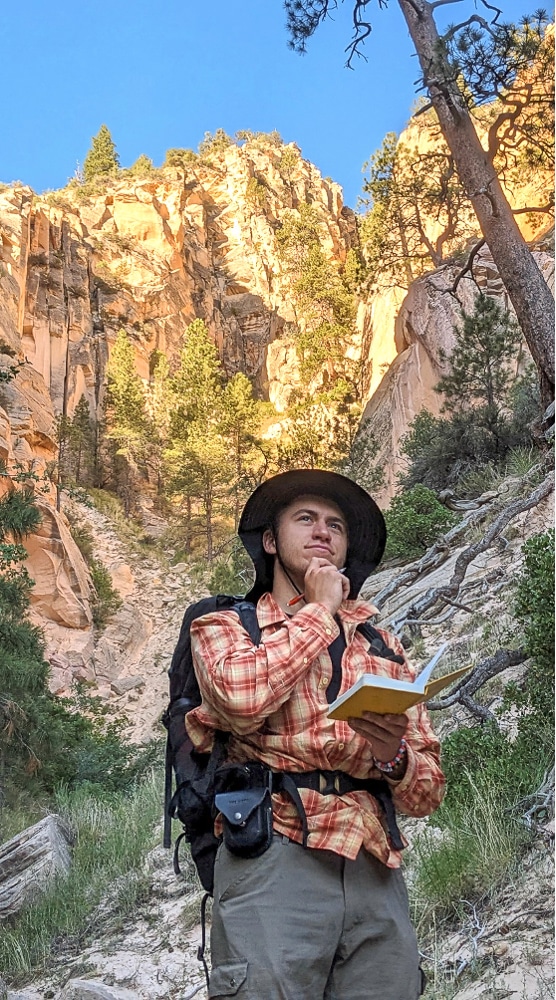
Jack, deep in thought
Audrey, measuring fracture orientations.
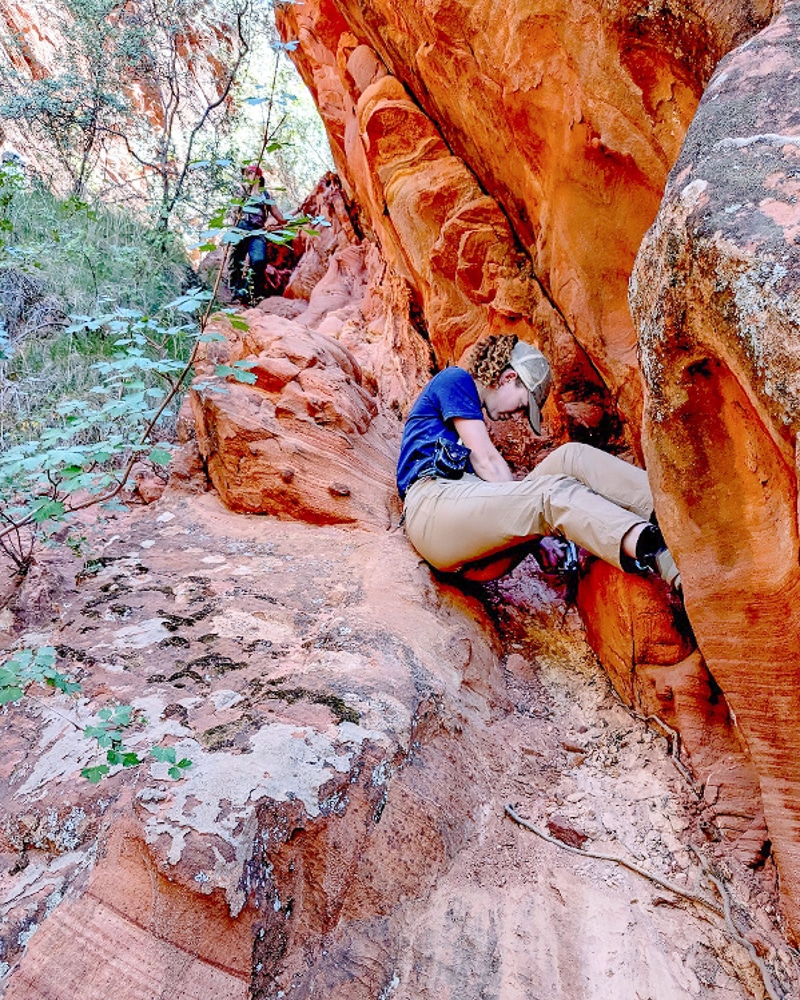
Midway through our time in Utah, we visited Zion National Park, admiring the stunning fracture networks exposed along the steep canyons that cut through the Navajo Sandstone. While there, we visited the Narrows, perhaps the best-known site in the National Park, we took a swim in the Virgin River, and we took time to talk about a range of topics, building on our campground and field conversations.
As we wrapped up our time in Utah, we began to consider how we might use the data we had learned to develop student projects. We began developing separate projects that leveraged field-based data to build hypotheses that students could test with 3D computer modeling, data analysis, and spatial interpretation. During our drive back to Trinity, we began to flesh out frameworks that would work for each student, and we began talking a bit more broadly about the future – what comes after graduation?
Science in the lab
Once back on campus and in the dorms, Pierce, Demi, Morgan, Audrey, and Jack dove into different types of model building or data analysis. Each of them spent most of the first few days developing their data analysis protocols and research project outlines that would form the foundation of their research efforts. Pierce used drone-based imagery to build 3D virtual outcrop models (VOMs) for spatially-accurate quantitative analysis in order to investigate the interplay of fault zone deformation and landscape evolution, Audrey developed virtual fault geometries that she could use to deform mechanically-accurate strata to learn more about how fault damage zones develop and interact, Jack investigated a major fault zone on Mars, considering what we can learn about terrestrial fault systems from the spectacularly well-exposed fault networks on the Red Planet, Morgan used drone-based imagery to build 3D VOMs in order to investigate the development of damage zones across fault zones, considering both the position of the damage zone relative to the fault as well as the changes in damage zone width with accumulating displacements, and Demi focused on building a 3D model of the entire fault network in order to validate ours and past researchers’ sub-surface fault interpretations.
In our last week, students wrote abstracts for Geological Society of America presentations at the fall annual meeting in Pittsburgh (GSA Connects 2023). I worked closely with students as they wrote and revised their abstracts over several days while completing their initial research efforts. Although their research results were preliminary as they wrote their abstracts, I helped them think through those results carefully in order to consider the implications of those initial findings (which are soooo cool – if you’re at GSA Connects, stop by and talk with them!). Although Demi will be studying abroad in the fall, she will likely present her research at a sectional meeting in the spring. I can see how these research results efforts will build toward broad, applicable conclusions that might impact the evaluation of energy resource potential in similar structural settings.
As the in-person portion of the project came to an end, we outlined what the next academic year might look like for all students, and we discussed how their projects related to each other. It was invigorating to see each student’s progress and potential; I think that all students finished with a strong sense of accomplishment and excitement for what’s next.
So, what’s next?
I’m now at Trinity, sitting in my office on a quiet campus, prepping for the new school year. Jack, Morgan, and Pierce are back home, getting ready to return to their campuses and considering what their projects will look like during the school year. Demi and Audrey presented their research posters at the Trinity Summer Research Symposium before returning home. As all students work toward their research goals, each will deal with a range challenges, but I think that our collaborative work during the summer should provide a model they can use to support each other, in spite of the distances between them. I look forward to an in-person reunion in Pittsburgh, when students will present their research progress to the broader geological community, and we’ll talk again about life, research, and the future.

